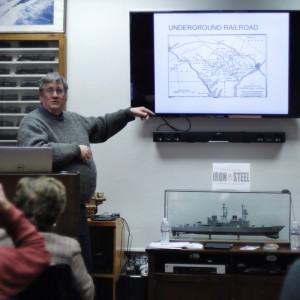Swarthmore library curator delivers lecture on Underground Railroad
By Kyle Carrozza, Staff Writer, The Times
COATESVILLE – In a country largely built by the unpaid forced labor of those who Moses Coates called “dark-skinned brethren,” Chester County became the home of many slaves who escaped the terrible institution through the Underground Railroad.
Christopher Densmore, curator of Swarthmore’s Friends Historical Library, gave a lecture at the National Iron and Steel Heritage Museum on Thursday night about the Underground Railroad in Chester County.
Though many paths of the passage to freedom ended in Canada, the self-emancipated slaves who traveled them often ended their journeys before reaching that far. Some Underground Railroad paths went not just south to north but west to east, allowing those on the run to find salvation in the area. At one point in the 19th Century, Pocopson Township was almost 30% black.
Densmore said that while black people still had little upward mobility, in Chester County, former slaves could find work on farms and in iron factories with a large number of them becoming barbers. In Kennett, nearly everyone over five years old, regardless of race, had at least some formal education. Densmore cited an 1890 piece of Democrat campaign literature in Maryland. The cover of the brochure showed a class picture from an integrated Kennett school. Below, it read, “Do you want Maryland to look like this?”
Perhaps most importantly, the self-emancipated found a relatively safe environment in Chester County. Staunch abolitionists, the area’s large Quaker population supported abolition and were not particularly inclined to turn in runaway slaves. Densmore said that they even harassed slave owners who ventured north looking for their slaves, asking them for proof of ownership and finding legal loopholes that would deem the owners’ pursuits unlawful.
Densmore recounted two incidents in particular where resistance went beyond legal loopholes and escalated to violence. During the Resistance at Gum Tree in 1850, federal agents came to Chester County looking for an escaped slave. In the middle of the night, the agents knocked on Nathan Green’s door asking for assistance in fixing a broken wagon. When Green opened the door, the agents raided his house. Green wielded an axe to protect himself, his wife, and six children. Though he was hit several times in the process, the agents eventually backed off and were run out of town by neighbors.
“You grabbed whatever you could to persuade people to go other ways,” said Densmore.
During 1851’s Christiana Riots, a group of Marylanders looked to capture four escaped slaves. The escaped slaves received assistance from local white abolitionists, and the situation turned violent. In the immediate aftermath of the skirmish, some abolitionists went to a nearby Quaker home for to seek treatment for wounds. While receiving treatment, the Quaker family received word that marshals were coming to capture the escaped slaves and arrest the abolitionists. The family dressed the fugitives in Quaker clothing, which allowed them to walk through the crowd of Marylanders unnoticed.
Densmore said that such stories have not received their deserved recognition in history books. Though historians have spent countless hours sifting through records to find the name of every soldier present at some Civil War battles, he had to read about Nathan Green’s story in a contemporaneous abolitionist newspaper.
He believes that it is important to preserve these stories so that people today can see how vested their ancestors were in coming up with solutions to racial problems in the US.
“People have this wonderful shared history. Rather than looking with suspicion at others, they can say, ‘Your ancestors were here and we were here; that’s really neat,” said Densmore.






Thank you for writing a story about my 3 times great grandfather Nathan green and his wife Mary green. Remembering the African American revolution is very important. He was born in fallow field west Chester in 1821.He helped hide and aide in the underground railroad. I am proud decedent.